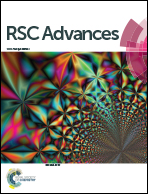Ru(bpy)2(phen-5-NH2)2+ doped ultrabright and photostable fluorescent silica nanoparticles†
Abstract
This work demonstrated that a series of ultrabright fluorescent silica nanoparticles have been synthesized and designed via the reverse microemulsion method to encapsulate (2,2′-bipyridine)2-(5-aminophenanthroline) Ru bis(hexafluorophosphate) (Rubpy-phen). Transmission electron microscopy (TEM), scanning electron microscopy (SEM), dynamic light scattering (DLS), inductively coupled plasma (ICP) and fluorescence spectra were used to study the morphology and properties of the nanoparticles. By introducing ethanol into the reaction system, the obtained uniform fluorescent nanoparticles showed monodispersity and controllable size. With an increase of nanoparticle size (from 50–180 nm), the relative brightness of the nanoparticles was greatly improved from 534 to 86 972 by comparison with free dye molecules. Due to the protection of the silica matrix, the fluorescence of high concentration dye-doped silica nanoparticles (Rubpy-phen NPs) is not quenched, which results in higher fluorescence intensity and relative brightness. Moreover, the silica matrix can also protect Rubpy-phen from leakage. Due to the high brightness and biocompatibility, Rubpy-phen NPs have potential applications in the biological field.


 Please wait while we load your content...
Please wait while we load your content...